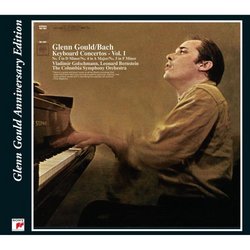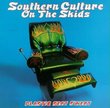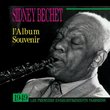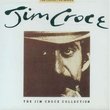| All Artists: Glenn Gould, Bach Title: Piano Ctos 1 4 & 5 - 70th Anniversary Edition Members Wishing: 0 Total Copies: 0 Label: Sony Release Date: 9/3/2002 Album Type: Limited Edition, Original recording remastered Genre: Classical Style: Symphonies Number of Discs: 1 SwapaCD Credits: 1 UPC: 696998776029 |
Search - Glenn Gould, Bach :: Piano Ctos 1 4 & 5 - 70th Anniversary Edition
CD DetailsSimilar CDs
|
CD ReviewsTHE ONE AND ONLY DAVID BRYSON | Glossop Derbyshire England | 12/27/2004 (5 out of 5 stars) "This disc does not amount to much in terms of playing-time, and the recorded balance is a little unfair to the orchestra, but I can still give it 5 stars at a bargain price. Sviatoslav Richter apparently said that in these performances the youthful Gould was not yet fully inside his own distinctive style. Maybe so, but the fact remains that Gould did more than everyone else combined to restore Bach-playing on the piano to respectability after the over-long ascendancy of the purist school who refused to admit that as even legitimate. Instruments exist for music, not music for instruments, so far as I'm concerned. Moreover Gould was, purely as a player, an out-and-out phenomenon, one that surpassed even Richter in my own opinion. He was a perfectionist to rival Michelangeli, though of course nothing like him in sound, and on this disc you will hear his trademark pearly evenness in the runs and passage-work and that amazing cut-diamond brilliance in the ornamentation. I think I know what Richter meant, but I would ascribe part of the cause at least to the recording, which highlights the solo unduly at the expense of the orchestra. These three concertos were recorded over the same two days in 1957, with the orchestra under two different conductors for reasons not stated. I wonder whether Gould subsequently got to know the performance, from 1964, of the 5th Brandenburg with Serkin at the piano and his Marlboro festival orchestra conducted by no less than Casals. This has now been reissued on the Sony label, and anyone looking for a model of how to do a Bach concerto with a big piano solo need look no further. Richter himself regretted not being able to take up Serkin's invitation to join the festival, and we will now never now know what might have come out of such a collaboration. At least two of the concertos are Bach's own arrangements of works for other instruments, not that one would ever realise. The liner note makes rather a meal of Gould's misgivings about the concerto form in general, and Gould has only himself to blame for this by talking too much, as he was always prone to doing. Despite that, it is still illuminating in a rather Teutonic way, and of course I am always glad to get any more of Gould's wonderful Bach-playing that I can find." This is the perfect Glenn Gould sampler. Jon. Yungkans | Whittier, CA USA | 05/31/2005 (5 out of 5 stars) "From the drama of the D Minor concerto to the songfulness of the A Major and the Machiavellian intrigue of the F Minor, Gould's technical clarity and articulation are consistently phenomenal, the music flows smoothly under his fingertips; his eloquence and lack of idiosyncrasy make his these performances among his most approachable and listener-friendly. Yes, there is Gould's trademark vocalize, most notably in the slow movement of the A Major, but it's a small price to pay for such wonderful performances, not only from Gould but also from the Columbia Symphony Orchestra - in this case, a pick-up ensemble consistently mainly of players from the New York Philharmonic. They, along with Gould and conductors Leonard Bernstein and Vladimir Golschmann, take a chamber music approach, and the resulting interplay between soloist and various members of the orchestra - made all the clearer with Sony's excellent remastering - adds to the joy of the overall proceedings. Sony has wisely upped the ante by adding two of Gould's finest solo Bach recordings. The 1959 performance of the Italian Concerto is the fleeter-fingered of his two traversals, and it is good to hear the "Concerto after Marcello" paired with it instead of Gould's lumpy remake. The Italian Concerto radiates the same ecstasy in playing that infused the three concertos preceding it - two fireballs of extreme dynamism framing a hushed central movement that keeps you at the edge of your chair with its rapt intensity. The "Concerto after Marcello" adds wit and, again, intrigue to this heady mix and shows there were still moments, even in the year before his untimely death, that Gould did not take himself as ponderously serious as was his wont. This, not the final version of the Goldberg Variations, is Gould's most fitting memorial. " These historic recordings are excellent even by today's soun C. B Collins Jr. | Atlanta, GA United States | 12/19/2005 (5 out of 5 stars) "Glenn Gould recorded the first of three concertos in 1957 with the Columbia Symphony Orchestra with Leonard Bernstein conducting. Then in 1959 he recorded the 4th and 5th concertos, again with the Columbia Symphony Orchestra but with Vladimir Golschmann conducting.
The CD starts with the Concerto Number 1 for Piano and Orchestra in D Minor and even though it was recorded in 1957 it will emerge from your speakers like an overpowering invasion of harmony and complexity. The first movement is extremely dramatic, building tension from the first notes, not as a tension between the piano and orchestra as some piano concertos are based, but rather on an internal searching tension expressed through the keyboard. The piece offers initial simplicity in early passages, but these quickly build to amazing complexity as canon after canon of variations layer one upon each other, never seeking a resolution, so that the listener's tension and expectation builds. He offers simple scales that quickly become any thing but simple and flow like wave after wave of pattern. It is in the middle of the first movement however that an amazing thing happens - Bach slows the tempo and reduces the piece to single notes of the piano that begin to verge on the atonal, stripping for only a few seconds the Baroque and revealing the minimal. Even in the first of a series of concertos he does not play safe, he pushes the limits. The first movement is wonderfully complimented and resolved in the second and third movements. In the third movement he returns to the atonal passage of the first movement and resolves it completely for the ear of the listener. The Concerto Number 4 for piano and orchestra in A Major as well as the Concerto Number 5 for piano and orchestra in F Minor are both beautiful, less dramatic and more light than the Concerto Number 1. Concerto Number 4 for piano and orchestra is very courtly with less dominance by the piano over the violins that you hear in Concerto Number 1. In the Concerto Number 1 the piano plays with the orchestra continually, completely integrated with it. The other two concertos also appear to be composed so that the keyboard is not isolated but integrated fully into all passages. In Concerto Number 4, the Larghetto middle movement, softens with the complimentary strings but the keyboard retains its independence and range. Concerto Number 5 for piano and orchestra has a second passage, the Largo, that appears on many "Best of Bach" type CDs. Here it is rewarding to hear the Largo integrated between the first movement "Allegro" and the third movement "Presto". These piano recordings require precise articulation on the keyboard and Glenn Gould certainly delivers that in these recordings." |


![Mozart: Serenades, Dances, Marches [Box Set]](https://nationalbookswap.com/cd//m/46/2846/6132846.jpg)





